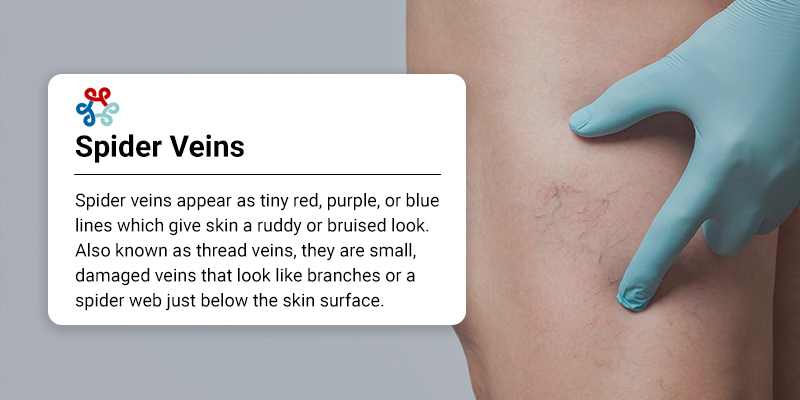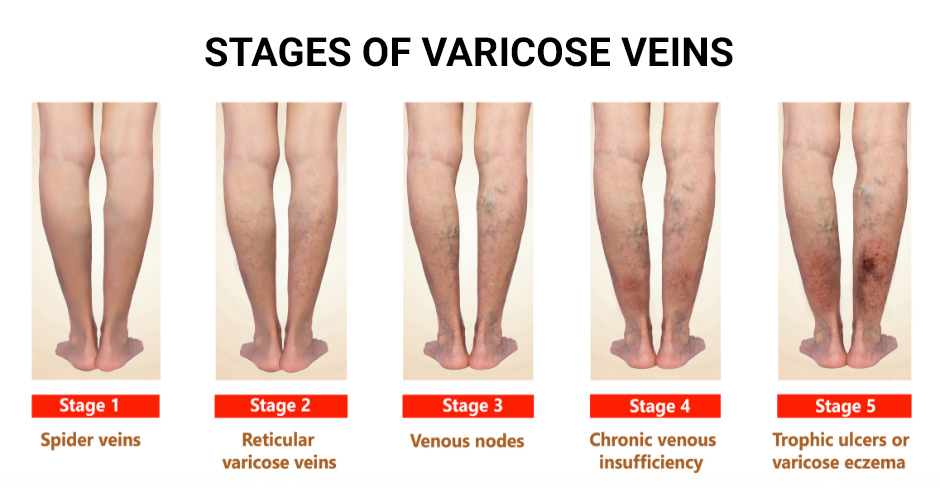

Home > Spider Veins and Varicose Veins: What’s the Difference?
Updated on May 23, 2023 by Dr. Jonathan Arad (Vein Doctor) of Vein Care Center
If you notice abnormal bulging or web of veins on your legs, feet, or other parts of the body, get yourself checked by an expert vein doctor. The appearance of blue, red, and purple veins may be an aesthetic drawback, but if they occur with a heaviness in the legs, swelling, and pain that does not seem to be alleviating, it could be a sign of some underlying disease. As a specialist in veins, Dr. Jonathan Arad at the Vein Care Center will identify the reasons behind vein bulging and discoloration using advanced diagnostic equipment and recommend effective treatments that work best for your condition.
Many people believe spider veins and varicose veins to be the same, but they are actually two separate vein disorders with distinct causes and symptoms.
These vein disorders not only affect the appearance of legs with twisted, bulging veins or causes redness or rashes, but they can also be painful and also lead to more serious problems. You must seek medical attention to have your condition diagnosed by an expert physician and to know their possible causes.
The main reason behind spider and varicose veins is pressure inside the veins. Veins return blood from the body to the heart. When veins in the lower part of the body, particularly legs, fail to push the blood upwards, it causes circulation problems. These circulatory problems lead to venous insufficiency and other symptoms. Varicose and spider veins are recognized by their enhanced visibility and prominence through the skin.
Difference Between the Spider and Varicose Veins
Spider and varicose veins are forms of venous insufficiency, but they are not the same. There are marked differences between these two conditions that help in diagnosing and alleviating them.

Varicose veins are large, twisted veins that bulge or become prominent on the skin surface. Blue, blue-green or dark purple in color and swollen, varicose veins are large in diameter as compared to spider veins and do not cluster like them. They are mostly found in the legs and result from malfunctioning or enlarging valves in the blood vessels. The blood moving through the veins is not transported back to the heart properly, and it begins to pool in the legs, leading to swelling and enlarged veins.
Identifying varicose veins
The varicose veins are a part of the superficial venous system. There is also a deep venous system, and these veins can become varicose even if you cannot see them. Varicose veins can result in complications, including spontaneous bleeding, blood clots in deep veins, or ulcers on the skin and discoloration of skin if they are not cared for timely. People with varicose veins are also more likely to develop deep vein thrombosis (DVT).
Varicose veins usually manifest themselves in the lower part of the body and cause the following symptoms:
Pregnant women or women going through the menstrual cycle suffer from intense symptoms due to an increased flow of blood in the veins. In some cases, varicose veins can lead to thrombophlebitis, a severely painful blood clot that increases the inflammation of the vein and requires immediate medical attention.

Spider veins appear as tiny red, purple, or blue lines which give skin a ruddy or bruised look. Also known as thread veins, they are small, damaged veins that look like branches or a spider web just below the skin surface. Spider veins are often caused by conditions like obesity, heredity, pregnancy, and menopause.
They might result from some venous issues, but spider veins do not cause severe symptoms or lead to further complications.
Identifying spider veins
Spider veins are mostly found on the nose, cheeks, legs, and feet.
Spider veins are usually cosmetic, but any complication can result in the following symptoms:
They might look similar at first glance, but varicose and spider veins are very different if you look closely. Varicose veins are raised, swollen blood vessels that twist and turn beneath the skin. On the other hand, spider veins are smaller, more superficial blood vessels. Also, varicose veins can be very painful and uncomfortable and require treatment whereas spider veins do not cause any inconvenience except creating a visible web of red and blue veins on the skin.
You must seek immediate medical assistance if the affected veins become swollen, red, very tender, or warm to the touch. If you develop sores or rashes on the leg or near the ankle or the varicose veins begin to bleed, it could be a sign of a blood clot that needs proper treatment.
Whether you are facing varicose or spider veins, you will get effective solutions that take care of pain, bulging, and discoloration most successfully. The vein doctor will examine your condition carefully, run diagnostic tests to know if your varicose or spider veins are symptomatic or cosmetic, and come up with the best relief options. The specialist will help you understand varicose and spider veins and how to manage them.
The doctor may recommend non-surgical, outpatient laser treatment options for varicose veins, including endovenous laser treatment, radiofrequency ablation, foam sclerotherapy to fix venous reflux and eliminate varicose and spider veins.
If you notice any change in your condition or venous insufficiency begins to affect your daily life activities, do not waste time seeking a doctor’s help. Dr. Jonathan Arad at the Vein Care Center will carefully examine your legs and feet to determine which venous disease you are suffering from and if it is a cause for concern. He will differentiate between varicose and spider veins and suggest the most targeted treatments and remedies to relieve your symptoms.
Dr. Jonathan Arad has either authored or reviewed and approved this content.